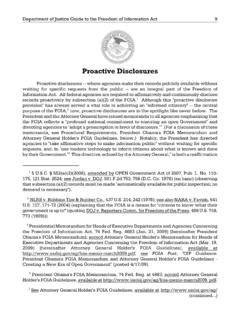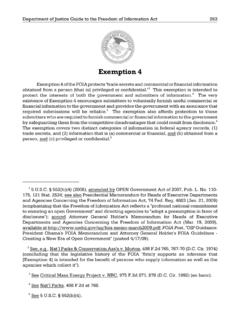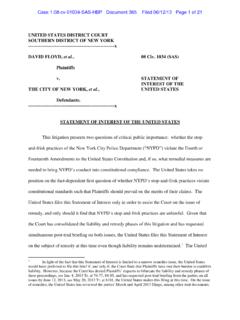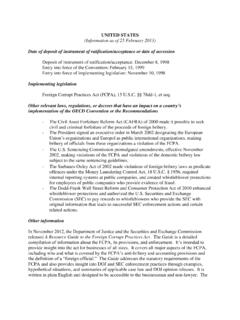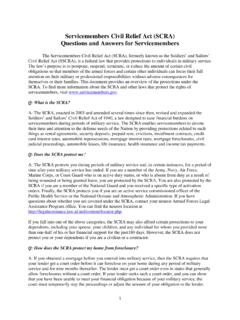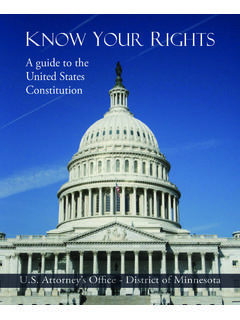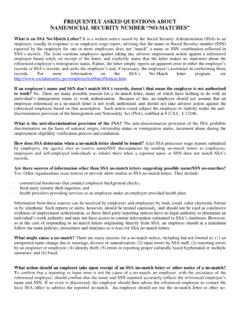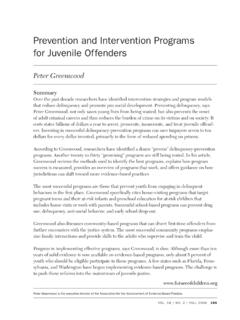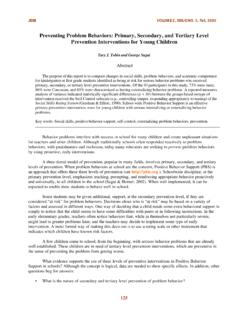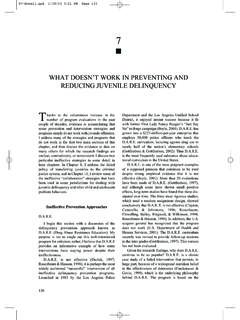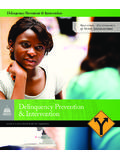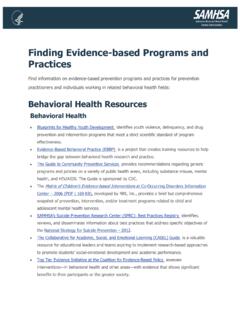Transcription of Tips for Teachers
1 Trauma-Informed Care for Children Exposed to ViolenceTips for Teachers What happens when children are exposed to violence? Children are very resilient but they are not unbreakable. No matter what their age, children are deeply hurt when they are physically, sexually, or emotionally abused or when they see or hear violence in their homes and communities. When children see and hear too much that is frightening, their world feels unsafe and insecure. Each child and situation is different, but exposure to violence can overwhelm children at any age and lead to problems in their daily lives.
2 Some children may have an emotional or physical reaction. Others may find it harder to recover from a frightening experience. Exposure to violence especially when it is ongoing and intense can harm children s natural, healthy development unless they receive support to help them cope and heal. What are some of the warning signs of exposure to violence? Children s reactions to exposure to violence can be immediate or appear much later. Reactions differ in severity and cover a range of behaviors. People from different cultures may have their own ways of showing their reactions. How a child responds also varies according to age.
3 Young Children (5 and younger) Young children s reactions are strongly influenced by caregivers reactions. Children in this age range who are exposed to violence may: Be irritable or fussy or have difficulty calming down Become easily startled Resort to behaviors common to being younger (for example, thumb sucking, bed wetting, or fear of the dark) Have frequent tantrums Cling to caregivers Experience changes in level of activity Repeat events over and over in play or conversation Elementary School-Age Children (6 12 years) Elementary and middle school children exposed to violence may show problems at school and at home.
4 They may: Have difficulty paying attention Become quiet, upset, and withdrawn Be tearful and sad and talk about scary feelings and ideas Fight with peers or adults Show changes in school performance Want to be left alone Eat more or less than usual Get into trouble at home or school Children Exposed to Violence: Tips for Teachers 1 Teenagers (13 18 years) Older children may exhibit the most behavioral changes as a result of exposure to violence. Depending on their circumstances, teenagers may: Talk about the event all the time or deny that it happened Refuse to follow rules or talk back with greater frequency Complain of being tired all the time Engage in risky behaviors Sleep more or less than usual Increase aggressive behaviors Want to be alone, not even wanting to spend time with friends Experience frequent nightmares Use drugs or alcohol, run away from home, or get into trouble with the law What can Teachers do?
5 Teachers can play a critical role in preventing and reducing the impact of exposure to violence on children. They can help children by creating a predictable environment, listening to students stories, and assuring children and adolescents that whatever happened was not their fault. Specific ways to help children exposed to violence include: Knowing and watching for signs of possible exposure to violence No single behavior proves that a child has been exposed to violence, but Teachers can watch for: Physical signs such as bruises Unexplained changes in behavior Emotional signs such as depression, mood swings, and fearful or anxious behavior Depending on the age of the child, Teachers can observe if a young child is crying more than usual, is difficult to calm, startles easily, or screams and panics during sleep.
6 School-age children may become more aggressive and fight a lot, return to old fears or develop new ones, become apprehensive about going home, express a wish that the teacher were the parent, or become overly active. Teenagers may use violence to get what they want, rebel in school, stop being concerned about their appearance, or refuse to follow rules. Responding appropriately to children s dis-closures A teacher s willingness to listen to a child s story can provide the foundation on which to increase resilience and personal strength. The most meaningful assistance Teachers can offer children exposed to violence is a safe and comfortable environment where children can talk.
7 Students may talk about exposure to violence all at once or in bits and pieces and test the teacher s responses. The teacher s first responsibility is to follow school policies and procedures and refer the child to specialized professionals such as the school social worker or psychologist. Supporting the healing process Experts agree that a child s relationship with a caring adult is critical for developing resilience and beginning the healing process. It is very important that students have an opportunity to talk about what they have witnessed and how they feel with caring Teachers who can listen and understand.
8 Another important priority for Teachers is to create an emotionally safe place for all children to learn. These safe spaces will enable children who have been exposed to violence to begin their healing journey. How do you know if more help is needed? Children exposed to violence may need specialized assessment and interventions that Teachers cannot provide. If that is the case, Teachers should refer children to other professionals within or outside the school system. Psychologists, social workers, or school counselors can help children and their families by looking at ways to keep current problems from getting worse.
9 In some instances, they may help families find ways to stop the cycle of violence. 2 Children Exposed to Violence: Tips for Teachers Safe Start: Working Together to Help Children Exposed to Violence Safe Start: Working Together to Help Children Exposed to Violence 3 Children Exposed to Violence: Tips for Teachers In addition, a number of interventions provided in schools have shown effectiveness in working with children exposed to violence. Information about the following interventions is available at the National Child Traumatic Stress Network Web site ( ): Cognitive Behavioral interventions for Trauma in Schools (CBITS) UCLA Trauma/Grief Curriculum School Intervention Project (SIP) of the Southwest Michigan Children s Trauma Assessment Center Trauma Center Community Services Program Mandated Reporting Many children experiencing crises or violence are also at risk for child abuse and neglect.
10 All States have child welfare systems that receive and respond to reports of child abuse and neglect, offer services to families, provide foster homes for children who must be removed from their parents care, and work to find permanent placements for children who cannot safely return home. Domestic violence does not equal child abuse and neglect, and therefore not all cases of domestic violence must be reported to child protective services. When responding to families affected by domestic violence, it is very important to consider simultaneously the safety of the child and the safety of the adult victim.
